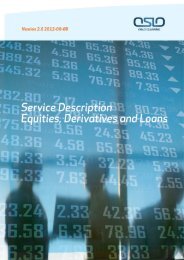Oslo Clearing ASA Self Assessment ESCB-CESR Recommendation
Oslo Clearing ASA Self Assessment ESCB-CESR Recommendation
Oslo Clearing ASA Self Assessment ESCB-CESR Recommendation
Create successful ePaper yourself
Turn your PDF publications into a flip-book with our unique Google optimized e-Paper software.
The derivatives segment is in majority based on the full segregation of end client<br />
positions and collateral, with an unambiguous right for <strong>Oslo</strong> <strong>Clearing</strong> to port out these<br />
end clients, should their clearing member enter into default. This reduces the<br />
potential loss impact for <strong>Oslo</strong> <strong>Clearing</strong>. Presently <strong>Oslo</strong> <strong>Clearing</strong> relies solely on its own<br />
funds to absorb losses in the derivatives segment.<br />
The regular stress testing performed by <strong>Oslo</strong> <strong>Clearing</strong> shows that the own funds of<br />
<strong>Oslo</strong> <strong>Clearing</strong> are more than sufficient to withstand the default of the largest exposure<br />
under extreme, but plausible market conditions.<br />
Has the CCP developed scenarios of extreme but plausible market conditions for this<br />
purpose and conducted stress tests accordingly?<br />
The stress test methodology of <strong>Oslo</strong> <strong>Clearing</strong> is based on classifying all underlying<br />
equity market instruments, indexes and interest rate instruments in nine (9) different<br />
market segments, and altering prices in three (3) directions (up, down and<br />
unchanged) according to specific rules for how market segments interact. The result<br />
is 369 different, but plausible, market scenarios.<br />
The same scenarios are applied to both equity and derivatives markets as well as<br />
collateral in form of equity market instruments, interest rate instruments, and cash<br />
denominated in foreign currency.<br />
What scenarios are evaluated? Do the scenarios include the most volatile periods that<br />
have been experienced by the markets for which the CCP provides services?<br />
The 369 scenarios do not include inconsistent combinations of price movements per<br />
segment. Price movements per segment are derived from the current margin rates<br />
per underlying market instrument, and scaled with a factor in order to test outcomes<br />
with at least 4 standard deviations. <strong>Oslo</strong> <strong>Clearing</strong> has defined a floor of 16 pct. to be<br />
the minimum price change under stressed market conditions. The stress test<br />
methodology, although scenario based, has thus been designed so as to include the<br />
most volatile periods that have been experienced.<br />
The dynamics of the stress test methodology implies that the regular factor<br />
adjustments on the margin rates affect the levels for stress testing. In addition, <strong>Oslo</strong><br />
<strong>Clearing</strong> has introduced minimum stress test levels in order to permanently reflect<br />
the price movements observed for the most volatile periods in the markets cleared.<br />
Does the CCP at least have sufficient resources to in the event of default by the<br />
participant with the largest exposure? Has the potential for multiple simultaneous<br />
defaults been evaluated?<br />
<strong>Oslo</strong> <strong>Clearing</strong> measures the stress test as the value, given the default of one<br />
member, and its largest end client (only applicable for the derivatives segment),<br />
calculated across all members and all scenarios.<br />
For internal purposes, multiple simultaneous defaults are also considered. The largest<br />
two exposures are calculated and reported on a daily basis.<br />
Are stress tests performed at least monthly, with a comprehensive reconsideration of<br />
models, parameters and scenarios occurring at least annually?<br />
26/69



